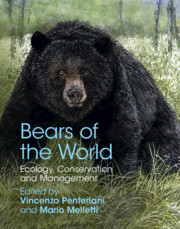Book contents
- Bears of the World
- Bears of the World
- Copyright page
- Dedication
- Frontispiece
- Contents
- Contributors
- Foreword
- Acknowledgments
- Introduction
- Part I Systematics, Ecology, and Behavior
- Part II Species Accounts
- Part III Human–Bear Coexistence
- Chapter 15 Human–Bear Conflicts at the Beginning of the Twenty-First Century: Patterns, Determinants, and Mitigation Measures
- Chapter 16 Principles of Human–Bear Conflict Management in Challenging Environments
- Chapter 17 Patterns of Bear Attacks on Humans, Factors Triggering Risky Scenarios, and How to Reduce Them
- Chapter 18 Effects of Human Disturbance on Brown Bear Behavior
- Chapter 19 Bears in Human-Modified Landscapes: The Case Studies of the Cantabrian, Apennine, and Pindos Mountains
- Part IV Conservation and ManagementConservation and Management
- Index
- Miscellaneous Endmatter
- Plate Section (PDF Only)
- References
Chapter 17 - Patterns of Bear Attacks on Humans, Factors Triggering Risky Scenarios, and How to Reduce Them
from Part III - Human–Bear Coexistence
Published online by Cambridge University Press: 16 November 2020
- Bears of the World
- Bears of the World
- Copyright page
- Dedication
- Frontispiece
- Contents
- Contributors
- Foreword
- Acknowledgments
- Introduction
- Part I Systematics, Ecology, and Behavior
- Part II Species Accounts
- Part III Human–Bear Coexistence
- Chapter 15 Human–Bear Conflicts at the Beginning of the Twenty-First Century: Patterns, Determinants, and Mitigation Measures
- Chapter 16 Principles of Human–Bear Conflict Management in Challenging Environments
- Chapter 17 Patterns of Bear Attacks on Humans, Factors Triggering Risky Scenarios, and How to Reduce Them
- Chapter 18 Effects of Human Disturbance on Brown Bear Behavior
- Chapter 19 Bears in Human-Modified Landscapes: The Case Studies of the Cantabrian, Apennine, and Pindos Mountains
- Part IV Conservation and ManagementConservation and Management
- Index
- Miscellaneous Endmatter
- Plate Section (PDF Only)
- References
Summary
The media and scientific literature are increasingly reporting an escalation of large carnivore attacks on humans, mainly in the so-called developed countries, such as Europe and North America. Although large carnivore populations have generally increased in developed countries, increased numbers are not solely responsible for the observed rise in the number of attacks. Of the eight bear species inhabiting the world, two (i.e. the Andean bear and the giant panda) have never been reported to attack humans, whereas the other six species have: sun bears Helarctos malayanus, sloth bears Melursus ursinus, Asiatic black bears Ursus thibetanus, American black bears Ursus americanus, brown bears Ursus arctos, and polar bears Ursus maritimus. This chapter provides insights into the causes, and as a result the prevention, of bear attacks on people. Prevention and information that can encourage appropriate human behavior when sharing the landscape with bears are of paramount importance to reduce both potentially fatal human–bear encounters and their consequences to bear conservation.
Keywords
- Type
- Chapter
- Information
- Bears of the WorldEcology, Conservation and Management, pp. 239 - 249Publisher: Cambridge University PressPrint publication year: 2020
References
- 1
- Cited by

